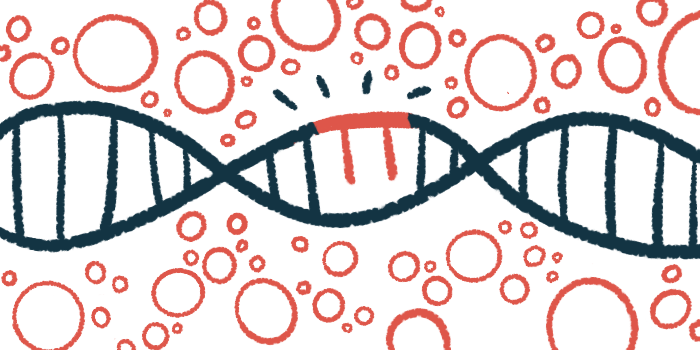MDA 2023: Zolgensma may benefit patients with more SMN2 copies
Real-world data show most children improved or maintained motor function
Written by |

Most spinal muscular atrophy (SMA) patients with four or more copies of the backup SMN2 gene achieved or maintained motor milestones after treatment with Zolgensma (onasemnogene abeparvovec), according to real-world data from the RESTORE patient registry.
The one-time gene therapy from Novartis was also found safe in these patients, with no new safety signals identified compared with previous studies.
The findings were presented by Richard Finkel, MD, director of the Center for Experimental Neurotherapeutics at St. Jude Children’s Research Hospital in Memphis, Tennessee, at the Muscular Dystrophy Association’s MDA Clinical & Scientific Conference, held March 19-22, in Texas and virtually.
His talk was titled “Outcomes in Patients with Spinal Muscular Atrophy and Four or More SMN2 Copies Treated with Onasemnogene Abeparvovec: Findings from RESTORE Registry.” The analysis was funded by Novartis Gene Therapies.
Zolgensma gene therapy designed to provide working version of SMN1
The most common SMA types are caused by mutations in both copies of the SMN1 gene — one inherited from the biological mother and one from the father — leading to little or no production of the SMN protein.
In addition to SMN1, cells also have a “backup” SMN-producing gene called SMN2, which remains intact in patients. While most people have two copies of this gene, others have extra copies, which is generally associated with greater SMN production and a milder form of the disease.
Despite its known correlations with disease severity and age at SMA onset, the number of SMN2 copies alone isn’t enough to predict a person’s disease course, Finkel noted.
For example, while patients with four or more copies are more likely to have milder forms of the disease, about 10% of patients will develop symptoms in the first year of life, requiring “early treatment … to prevent serious, progressive, potentially life-threatening SMA,” he said.
Zolgensma is a form of gene therapy designed to provide patients with a working version of SMN1. It’s approved in the U.S. for patients 2 years old and younger with any SMA type caused by an SMN1 mutation. In Europe, Zolgensma is approved for children with SMA type 1 or presymptomatic children who have two or three SMN2 copies.
While the effects of Zolgensma in people with 2-3 SMN2 copies is well-established, less is known about how the gene therapy affects those with a higher copy number, who have mostly been excluded from clinical trials.
“We’re trying to sort out which patients should be treated and when should they be treated,” Finkel said. “We don’t want to wait until symptoms have fully evolved because we cannot rescue them and we cannot go back and recapture the lost motor neurons.”
To learn more, the researchers evaluated data from SMA patients with four or more SMN2 copies included in the Novartis-sponsored RESTORE (NCT04174157), a multinational, real-world SMA registry that’s tracking patient outcomes for up to 15 years.
The registry is non-interventional, meaning investigators aren’t tracking the effects of a certain treatment, but some babies included in the registry have been given Zolgensma.
A total of 19 Zolgensma-treated patients with four or more SMN2 copies were identified in the registry — 12 had four SMN2 copies and seven had five or more.
All of these 11 boys and eight girls were diagnosed by newborn screening, and 18 of them were not exhibiting symptoms at the time of their diagnosis, Finkel noted.
Zolgensma was administered at a median age of 3 months and, over a median follow-up in the registry of 15.4 months, no additional treatments were given to participants.
“Patients … have not been pre-treated with another drug, they’ve not been post-treated, there’s no sequential or combination treatment,” Finkel said.
He also noted that assessments of motor milestones and tests of motor function were conducted by each child’s physician following usual SMA practices in each country. Thus, data were not collected on a set schedule or with standardized measures as happens in clinical trials.
Results showed that, of 16 children with at least two evaluable assessments from their doctor, 12 improved or maintained motor function or achieved new motor milestones expected for their age.
We’re trying to sort out which patients should be treated and when should they be treated. We don’t want to wait until symptoms have fully evolved because we cannot rescue them and we cannot go back and recapture the lost motor neurons.
Early diagnosis and intervention important to optimize patient outcomes
All seven children who underwent the Children’s Hospital of Philadelphia Infant Test of Neuromuscular Disorders — a test of motor skills mainly for children up to age 2 — achieved or maintained a maximum score of 64, reflecting good motor abilities.
For seven who underwent the Hammersmith Infant Neurological Exam, a scale of motor milestone attainment, one experienced a clinically meaningful improvement.
The Hammersmith Functional Motor Scale Expanded, a test of motor function used in children 2 and older, was conducted in six children. Two of them experienced clinically meaningful improvements after Zolgensma.
Overall, three adverse events were considered related to Zolgensma. No new safety signals were identified compared with previous reports from children with two or three SMN2 copies.
Finkel noted that the study was limited by the small number of participants and inconsistencies in data collection that are inherent to a registry study. Moreover, because the study lacked an untreated group for comparison, it is not known whether these children would have achieved motor milestones in the absence of Zolgensma.
Nonetheless, the findings have clinical importance. Although SMA patients with more SMN2 copies are usually expected to have less severe disease, their clinical presentation can vary, and testing for SMN2 copies isn’t always reliable, Finkel said.
The findings therefore highlight “the importance of early identification and intervention to optimize outcomes for all SMA patients,” he noted.








